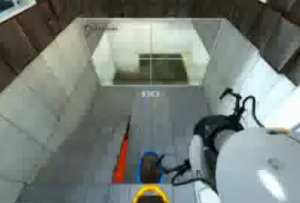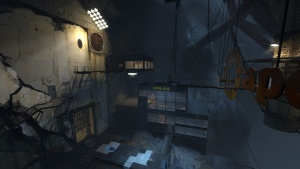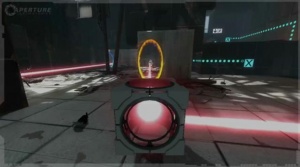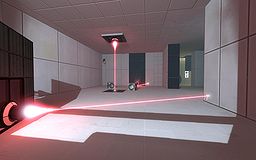What makes a good Portal 2 map?
January 2024
You can help by
January 2024
The goal of mapping is to make a map that players will find fun. This can either be achieved through a compelling story, good puzzles, or a combination of both. Note that most of these suggestions take examples from maps for both Portal and Portal 2.
What makes a good puzzle?
A good puzzle is a puzzle that makes the player think, but isn't too hard. The ultimate goal is to have the player say, "Aha!" and be able to, with little additional effort, solve the puzzle.
What makes a good flinging puzzle?
For short maps, flinging can be used right away because the player will most likely have played the original game before the map. The same goes for full-blown mods, however, a quick reintroduction may make sense in the story or make the player recognize flinging in a new environment. A good flinging puzzle, past the introduction, should be a means to move between puzzles, or as a constraint to make a puzzle harder. Puzzles that introduce new types of flinging should only involve that flinging type at the beginning, then add other puzzle elements later. Please note that in the Portal 2 engine, these flings can be predetermined by placing a trigger-catapult in a specific spot.
Case Study: Portal: Prelude - Chamber 9
This is a test chamber that introduces the "infinite fling", a method of flinging involving two portals on uneven surfaces.
What makes this map good:
- Easy to understand what must be done
- Multiple routes to the exit
What makes this map bad:
- VERY difficult to execute the fling. A greater vertical difference between the portals might have helped.
- Once the fling starts, the player must keep moving to maintain horizontal momentum. This causes there to be no opportunity to take a break.
- If the player loses momentum, their hard work will be lost, leading to great frustration.
Case Study: Portal 2 - sp_a3_transition01
This test chamber is pretty much just normal flinging. No new puzzle elements are involved.
What makes this map good:
- Cues are consistent: all flings either involve placing a portal on the only non-portalproof wall in the area or involve placing a portal on a tilted platform.
- Flings are fun: all flings cover long distances in visually distinct areas, making this a very fun map.
What makes this map bad:
- The map has no purpose other than story progression, and there's only one puzzle that's a bit tricky to figure out.
- Some flings are easy to mess up. For example, it is very easy to place a portal in the wrong spot on the second-to-last fling and get halfway through the fling before crashing into some rubble and falling to the ground, even though you had the correct solution.
Case Study: Try Anything Twice - Unreal Air
This uses a "booster" that allows you to be flung long distances. This testchamber must also be solved twice: once normally, then once with exploding cubes.
What makes this chamber good:
- Flinging is used only as a means to get between puzzles, or briefly as the puzzle itself - in other words, the testchamber, despite the name, has more than just flinging.
- All flinging is done in a visually distinct environment, making the chamber much more fun.
- It is pretty obvious when the player starts that they must fling. It is also obvious what the "boosters" do.
What makes a good Thermal Discouragement Beam puzzle?
Features of the Thermal Discouragement Beam:
- Emanates from a panel in the wall.
- Can activate laser relays, some of which are in the ground and some of which are in the wall.
- Can harm the player, and will knock back the player
- Can burn turrets, causing them to explode
- Can go through glass
- Cannot go through any other material types
- Can be redirected by portals or by Discouragement Redirection Cubes
Thermal Discouragement Beams are best used in addition to other puzzle elements. They can also, due to their knockback, be used to discourage (no pun intended) players from entering an area. Many puzzles involve adjusting the angle of beams to hit laser relays through a portal. These puzzles, while good in moderation, have become disliked by the community due to having to fiddle around with the laser cubes so much.
Case Study: Portal 2 - sp_a2_triple_laser
This is an example of the above. However, this is one of only two maps like this in the single-player campaign, so it is okay to use here.
What makes this map good:
- Looks very good
- The puzzle is easily done once the solution is known
What makes this map bad:
- Very short
- Is a little bit "fiddly" because of the angle of the beams
What makes a good Aerial Faith Plate puzzle?
Features of the Aerial Faith Plate:
- Flings the player long distances
- Flings physics objects long distances
- Everything it flings goes to a specific "target"
Aerial Faith Plates can be used in very much the same way flings are, but without the requirement of placing a pit in the map. Aerial Faith plates can also realistically fling the player farther than a fling can.
Case Study: Portal 2 - sp_a2_ricochet
This map is simple - the player must lower panels so that they can bounce between Aerial Faith Plates to the exit. Lowering the panels, however, turns into a good challenge - the player must fling to a cube, lower the first panel with it, fling up to a button, receive a laser cube, use it to block the laser controlling the first panel instead of the cube, activate a laser receptacle, then finally bounce up to the exit.
What makes this map good:
- Provides a good challenge, but is easily executed once the solution is known
- There is more than one way to get to the exit. Some are intended, such as lowering both panels with only the laser cube, but some are not, such as using a cube to block a laser at just the right time to make the panel hit the player, sending them upward to the exit.
- Music in the chamber is well-balanced between ambient beats, an Aerial Faith Plate percussion solo, and a laser melody.
What makes this map bad:
- Destroyed theme does tend to distract from the chamber, causing confusion about what is useful for the puzzle and what is unnecessary.
What makes a good Hard Light Bridge puzzle?
Features of the Hard Light Bridge:
- Players can walk on the bridge, and objects collide with hard light bridges.
- Is extendable through portals
- Can block turret fire
- Can be switched on and off
The Hard Light bridge is hard to make puzzles for and should be used with other elements. The usual puzzles involving only Hard Light Bridges just involve different portalable surfaces over goo, and usually are incredibly easy.
Case Study: Portal 2 - sp_a2_bridge_the_gap
This map just involves grabbing a cube, then placing a Hard Light Bridge, walking to the exit, and placing a cube on a button. It is not really a challenge but it does serve to solidify the concept of a Hard Light Bridge.
What makes this map good:
- Simple map
- Deaths are easily avoidable unless you walk off a Hard Light Bridge
What makes this map bad:
- The chamber is really short and not a challenge at all.
Case Study: 12 Angry Tests - Map 3, Test 2
This test is a complex map that makes heavy use of the Hard Light Bridge. The map includes a laser with a redirection cube, a single turret, cubes, buttons, and emancipation grids. This makes the solution not obvious but easy to pull off when understood. What makes this map good:
- A mix of test elements makes the test very engaging.
- The Hard Light Bridges are there more as a restriction on where the player can go than as an actual test element.
- The turret has a top hat and mustache, providing a small amount of humor in the map.
- The turret only exists as a restriction, not as a "OMG THINK QUICK" element.
- The solution involves using the laser redirection cube in a manner that is not obvious at first.
What makes this map bad:
- Autosaves are not common, so step off of a Hard Light Bridge and you'll have to redo at least half of the level.
- The turret's increased knockback can lead to some frustrating deaths after the player tries to use a cube as a shield only to be knocked off of the bridge by a stray bullet.
What makes a good Repulsion Gel test?
Features of Repulsion Gel:
- Bounces both players and physics objects up to the height that they bounced from
- Bounces physics objects at a random angle
- Can coat boxes and turrets, causing them to bounce wildly
- Can be washed off by water
- Can either be pre-placed or dropped from dispensers
- Can be redirected by portals
Repulsion Gel is the first introduced gel, and by far, the simplest. However, it is still a very good test element, and when used correctly, can even make a good test on its own. Still, as with all test elements, it is good to use in conjunction with other test elements.
Case Study: Portal 2 - sp_a3_bomb_flings
This map introduces the concept of redirecting gel through portals. The solution requires multiple player flings and paint "bomb" flings. What makes this map good:
- The map is a good introduction to the concept of gel redirection.
- Even though it is a good introduction, it still provides a great challenge.
- There are multiple ways to the exit.
What makes this map bad:
- The first "puzzle" involves just hunting down a surface that you can place a portal on.
- It can take a bit of time for the player to realize that gel can be redirected through portals.
What makes a good Propulsion Gel test?
Features of Propulsion Gel:
- The player speeds up when they are on it.
- Can be redirected through portals
- Can coat boxes, making them "slippery"
- A streak of Propulsion Gel next to a spot of Repulsion Gel, when run on, causes players to be propelled forward and upwards



